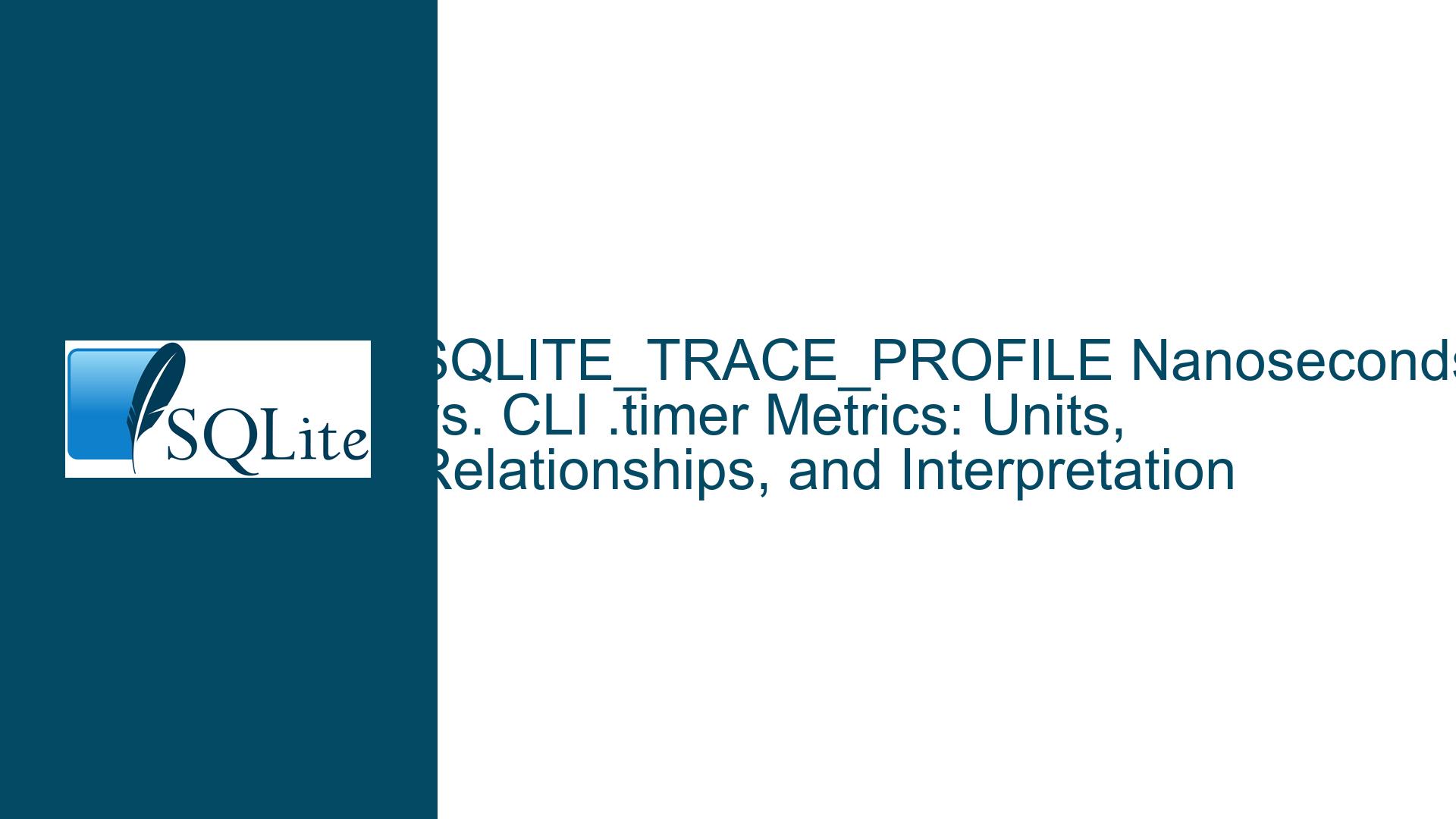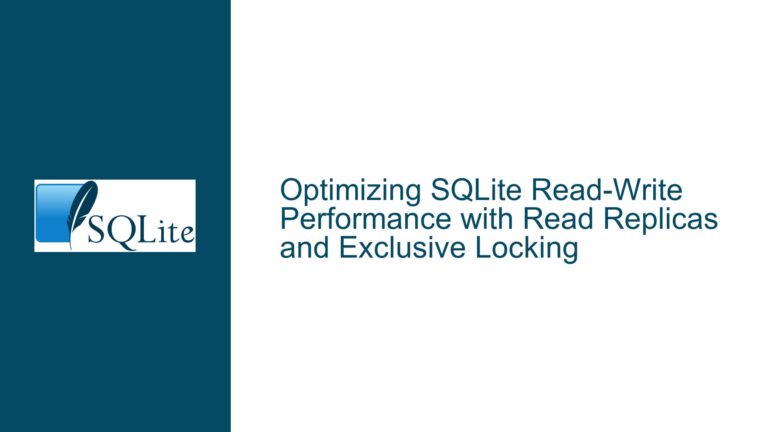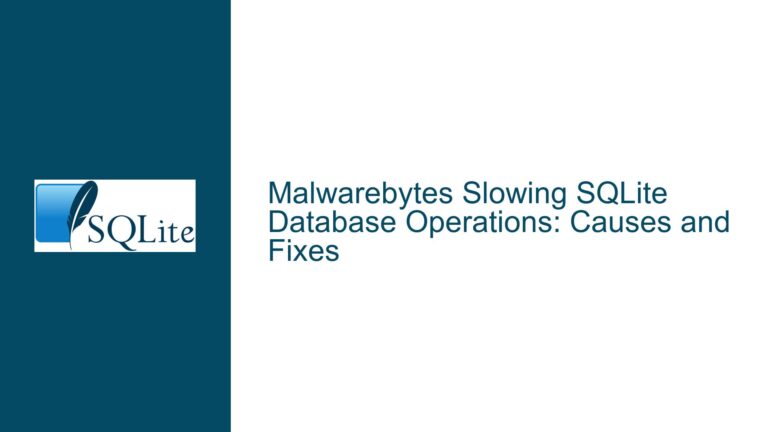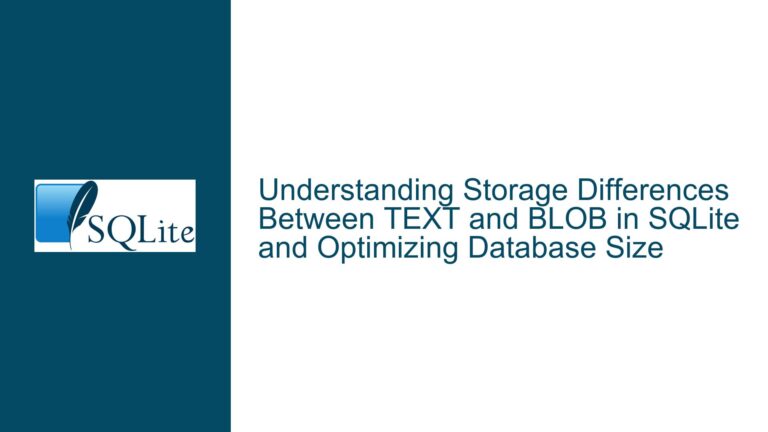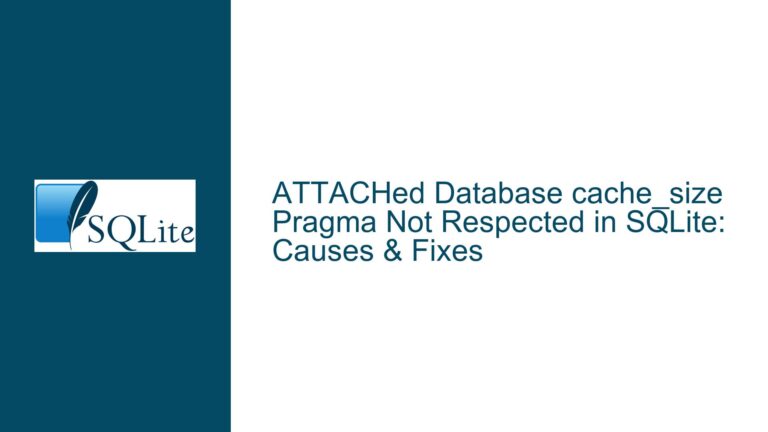SQLITE_TRACE_PROFILE Nanoseconds vs. CLI .timer Metrics: Units, Relationships, and Interpretation
Understanding SQLITE_TRACE_PROFILE Execution Time Metrics and CLI .timer Outputs
1. Core Definitions and Relationships Between SQLITE_TRACE_PROFILE and CLI .timer Metrics
The SQLite C API’s sqlite3_trace_v2 function, when configured with the SQLITE_TRACE_PROFILE flag, provides a callback that reports the time taken to execute a prepared statement as a 64-bit integer representing nanoseconds. This metric is intended to measure the actual execution duration of the SQL operation.
In contrast, the SQLite command-line interface (CLI) tool’s .timer command outputs three time metrics: Real, User, and Sys. These metrics originate from the operating system’s process-level time-tracking mechanisms. The User and Sys times are derived from the POSIX-standard getrusage() system call, which populates the ru_utime (user CPU time) and ru_stime (system CPU time) fields of the rusage struct. The Real time is measured as wall-clock time, typically using system calls like gettimeofday() or clock_gettime().
The critical relationship between SQLITE_TRACE_PROFILE and the CLI’s .timer metrics lies in their scope and granularity. The SQLITE_TRACE_PROFILE nanoseconds value corresponds to the Real (wall-clock) time reported by the CLI but with higher precision. However, discrepancies arise because User and Sys measure CPU time consumed by the process in user and kernel modes, respectively, while Real measures total elapsed time, including waits for I/O, locks, or other processes.
2. Causes of Confusion: Metric Units, Measurement Sources, and Documentation Gaps
The ambiguity stems from three factors:
- Unit Mismatch: The
SQLITE_TRACE_PROFILEreports nanoseconds as an integer, while the CLI’s.timeroutputs fractional seconds (e.g.,Real: 0.123). Users may misinterpret these as equivalent values without unit conversion. - Divergent Time Sources: The
SQLITE_TRACE_PROFILEcallback measures only the duration ofsqlite3_step()for a prepared statement. The CLI’s.timeraggregates time across all steps involved in executing a command, including parsing, optimization, and result serialization, which may include multiplesqlite3_step()calls. - Undocumented Behavioral Nuances: SQLite’s official documentation does not explicitly clarify the mapping between
SQLITE_TRACE_PROFILEand CLI metrics, nor does it specify whether Real time in the CLI aligns with the trace callback’s nanosecond value.
Additionally, the getrusage() function’s granularity varies by platform. On Linux, ru_utime and ru_stime are tracked with microsecond precision, but older systems or configurations may report coarser values. The wall-clock time (Real) is typically measured with microsecond or nanosecond precision, depending on the OS and hardware.
3. Resolving Ambiguities: Conversion, Validation, and Contextual Interpretation
To reconcile SQLITE_TRACE_PROFILE nanoseconds with CLI .timer metrics, follow these steps:
Step 1: Unit Conversion and Direct Comparison
Convert the SQLITE_TRACE_PROFILE nanoseconds value to seconds by dividing by 1,000,000,000. Compare this to the CLI’s Real time. For example, a trace value of 123,456,789 nanoseconds equals 0.123456789 seconds, which should approximate the CLI’s Real output if no external delays (e.g., I/O contention) occur.
Step 2: Isolate CPU Time Measurements
The User and Sys times from .timer reflect CPU time consumed, not wall-clock time. If a query spends significant time waiting for disk I/O, Real will exceed the sum of User and Sys. To validate this, run a CPU-intensive query (e.g., a complex mathematical calculation) and observe that User time dominates. Conversely, a query reading large blobs from a slow disk will show a higher Real time relative to User/Sys.
Step 3: Cross-Platform Validation
On Unix-like systems, use the time command to execute the CLI with a query and compare its output to the CLI’s .timer metrics. For example:
time sqlite3 test.db "SELECT SUM(a) FROM tbl;"
The time command’s real, user, and sys should correlate with the CLI’s Real, User, and Sys, confirming that the CLI’s timings derive from getrusage().
Step 4: Precision and Accuracy Testing
Run a minimal query (e.g., SELECT 1;) repeatedly using both the trace callback and CLI. Compute the average and standard deviation of the measurements. The SQLITE_TRACE_PROFILE values will exhibit lower variance due to nanosecond precision, whereas the CLI’s Real time may round to milliseconds or microseconds.
Step 5: Profiling Overhead Assessment
The sqlite3_trace_v2 callback introduces overhead, as the callback itself consumes CPU cycles. To estimate this overhead, register an empty trace callback and measure the difference in User time compared to a no-callback scenario. Subtract this overhead from traced execution times for accurate comparisons.
Step 6: Source Code Analysis
Review SQLite’s source code to confirm the relationship between metrics. In shell.c.in, the .timer command uses sqlite3Hwtime() for Real time (wall-clock) and getrusage() for User/Sys. The SQLITE_TRACE_PROFILE callback in main.c invokes sqlite3Hwtime() to compute duration, ensuring alignment with Real time in the CLI.
Final Interpretation Guidelines
- Use
SQLITE_TRACE_PROFILEfor microbenchmarking specific prepared statements. - Rely on CLI’s User/Sys for CPU time profiling and Real for end-to-end latency.
- Always document the measurement environment (OS, hardware, SQLite version) when reporting metrics.
By addressing unit conversions, measurement scope, and platform-specific behaviors, developers can accurately interpret SQLite performance data across tracing and CLI interfaces.
